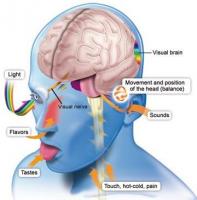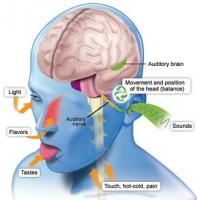Tous droits réservés © NeurOreille (loi sur la propriété intellectuelle 85-660 du 3 juillet 1985). Ce produit ne peut être copié ou utilisé dans un but lucratif.
Hearing is a sense that plays a primordial role in relations between living beings and their environment. All of the world’s animals use hearing for a variety of behaviours: defence, feeding, sexuality… In human beings, the role of hearing is even more important: with the development of vocal language, hearing has become the main means of social interaction and communication.
Hearing is the result of the collaboration between the ear and the auditory brain. An ear without a brain is like an unplugged microphone, but without ears we wouldn’t even be able to imagine what a sound was like!
Diagrams of the sensory organ/brain association
Six sensory organs receive stimulation from the environment (so let’s stop talking about our ‘five senses’!). They are situated in the eyes (light/vision), nose (odours/smell), mouth (flavours/taste) and all over the surface of our skin (touch, hot-cold, pain/general sensitivity). The last two are found in the inner ear: the cochlea (sounds/hearing) and the vestibule (motion and head position/balance).
These organs all work in a similar way: they capture the stimulus (either physical or chemical) and encode it into messages that are sent to the brain via specific nerves. In the brain, different relay stations analyse the message and decode it to produce a percept in the cerebral cortex.
Two examples are detailed below for vision and hearing.
Click on thumbnails below to see two examples for the viual and auditory sensations.
| |
|
Animation showing the partnership between the ear and the brain
Sound is captured by the outer ear, amplified by the middle ear and transferred to the inner ear or cochlea, which transforms the sound vibration into a neural signal. The auditory nerve feeds this coded message (which contains all of the sound’s attributes: loud or soft, high or low, short or long, etc...) to the brain where different structures work together to create a percept: I can hear!
 Français
Français
 English
English
 Español
Español
 Português
Português




Facebook Twitter Google+